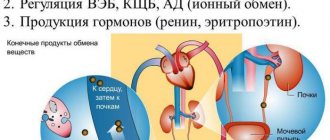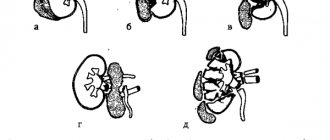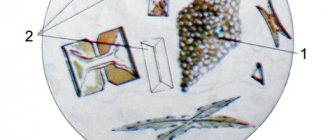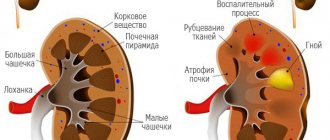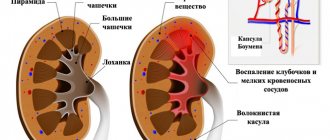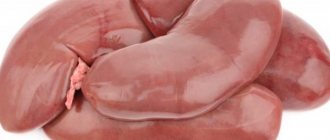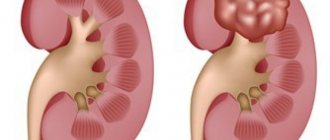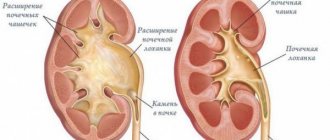Any pathological changes due to kidney injury leave a mark for the rest of life and lead to the death of any part of the nephrons - the structural units of the kidney. A kidney bruise does not lead to rupture of the organ capsule and extremely rarely causes life-threatening bleeding, but it never goes away without a trace .
Photo 1. Kidney bruises, even mild ones, do not go away without leaving a trace. Source: Flickr (Indus Health Plus)
Causes of injury
Kidneys are considered one of the most important human organs. Any damage can lead to very serious consequences, so a problem such as kidney injury cannot be ignored. The situation is aggravated if the human body is weakened. This organ is reliably protected by muscles, fatty and connective tissue, and ribs. But nowadays many people have pathologies of the urinary system.
Bruises in the kidney area can occur for the following reasons:
- abdominal trauma;
- falling on the back and buttocks;
- beating during a fight;
- traffic accident;
- strong impact during sports;
- high jumping or parachute jumping with a hard landing.
Injury can also occur due to a shock wave passing through the chest, abdomen, pelvis or thighs. It is impossible to cope with such a problem on your own. It is recommended to go to the trauma department to receive qualified assistance. The doctor will explain what to do in case of kidney bruises and prescribe appropriate treatment.
Causes of kidney tissue damage
Damage to kidney tissue occurs due to negative factors:
- falling on the street or at work, accompanied by severe bruising;
- blow to the kidney area, lower back;
- injuries resulting from plane crashes, traffic accidents, and other incidents on water, road, mountains or in the air;
- prolonged compression of the bean-shaped organs due to extreme conditions and disasters, for example, being under the rubble of a house after an earthquake;
- household damage (falling from a stepladder or stool, in a slippery bathroom, etc.).
Risk group:
- children. Excessive activity, outdoor games, thirst for knowledge of the world at an early age without understanding the possible consequences - the causes of falls, hits on the back with a ball, severe bruises;
- people professionally involved in football, boxing, diving, mountaineering, motocross, freestyle skiing and boarding, and other sports accompanied by falls, blows to the body, and unsuccessful landings;
- race car drivers, drivers, people driving various vehicles;
- patients with urolithiasis, nephroptosis, hydronephrosis, dystopia, horseshoe-shaped or L-shaped kidney. If the size, functions, location of the bean-shaped organs, or inflammation of the parenchyma are disturbed, even minor bruises or blows in the lumbar area can cause injury to the affected tissues.
Symptoms
The clinical picture of kidney injury is characterized primarily by severe pain in the lower back, which can radiate to the abdominal or groin area. Typical symptoms of kidney injury are:
- dull aching pain;
- pale skin;
- nausea;
- gagging;
- general weakness;
- muscle spasms;
- hematoma;
- presence of blood in the urine.
If the injury is very serious, the victim’s condition deteriorates sharply. It will have the following features added:
- sharp pain that is difficult to bear;
- dysfunction of urination;
- blood clots in urine;
- anemia;
- drop in blood pressure;
- state of shock.
This clinical picture may indicate internal bleeding. Particular attention should be paid to children, since kidney bruises are most common in children. The child cannot always accurately describe his feelings. To confirm the diagnosis, a diagnostic examination is necessary.
The lack of renal function, which can also be diagnosed in mild trauma, should also be alarming. The cause of this problem most often is blockage of the ureter and renal pelvis by blood clots. In this case, the clinical picture will be characterized as with renal colic.
All nonspecific symptoms of such an injury usually appear gradually. The time for symptoms to appear depends on the extent of the damage. If the kidneys are bruised due to a fall, the following symptoms will appear immediately after the injury:
- pain syndrome;
- pale skin;
- weakness.
After a short period of time, the victim’s health may deteriorate to the point of shock. The injured patient will also show signs of kidney injury:
- temperature increase;
- sudden jumps in blood pressure;
- nausea;
- gagging.
If urine and blood leak into the abdominal cavity, the victim experiences acute abdomen syndrome. The patient complains of sharp and severe pain in the abdomen. He is also diagnosed with pathological tension in the abdominal wall.
If a kidney injury occurs due to a fall or during a car accident, there is a high probability of damage to other organs, which significantly aggravates the situation. The victim may be diagnosed with:
- lung damage;
- rib fractures;
- bruise or rupture of abdominal organs.
The injured person must undergo a comprehensive diagnosis to identify all injuries. If a kidney injury occurs, you should contact the trauma department, and the doctor will advise you on what to do. Self-medication in this case poses a great danger to the health of the victim.
Mechanism and causes of kidney injury
Most often, kidney injuries occur as a result of road accidents . They account for about 75 - 80%. The remaining 20–25% comes from everyday circumstances, fights, sports , etc.
The kidney has fairly strong protection from the surrounding tissues. On the one hand, this makes it possible to avoid damage to the organ even under fairly strong traumatic influences; on the other hand, it often blurs the clinical picture, preventing timely diagnosis of a bruise or rupture. Structures protecting the kidney:
- Perirenal fatty tissue;
- Muscles of the lower back (back) and side wall of the abdomen (outside);
- In front, the kidney lies deep behind the intestinal loops.
All closed injuries and, in particular, bruises, occur not due to the direct impact of a traumatic factor, but due to the transmission of mechanical vibrations to the lower pair of ribs. When struck in the lumbar region, the 12th rib moves forward, thereby injuring the kidney.
It is important! The right kidney is located below the left, which is due to its close contact with the liver, which occupies the entire right subphrenic space. As a result, the 12th rib on the right crosses the kidney almost in the middle. This often leads to kidney rupture due to injury.
Degree of damage
According to symptoms, kidney bruise is classified into five degrees:
- First degree . The victim feels fine. He is diagnosed with a small hematoma under the kidney capsule. Neither the kidney itself nor the capsule have ruptures. The patient is prescribed conservative treatment for a kidney injury. He needs complete rest. The doctor monitors laboratory tests and conducts dynamic examination using ultrasound. If the hematoma does not enlarge, the victim can be treated at home.
- Second degree . With such a bruise, a slight tear of the kidney up to 1 cm occurs. A hematoma forms around the damaged organ in the perinephric tissue. Conservative treatment is carried out provided there is no increase in the size of the hematoma. The patient will need to spend the first couple of days in the hospital under the supervision of a doctor. If there are no complications, the victim will be able to go home and be treated at home.
- Third degree . The kidney parenchyma is quite deeply torn, but the pyelocaliceal system is not damaged. The patient is diagnosed with a large hematoma with a deep rupture of the kidney. No urine comes out. Conservative treatment is allowed.
- Fourth degree . The stage is characterized by damage to the pyelocaliceal system with a deep rupture of the kidney. The torn area of the injured organ is not separated, but urine flows out. Blood flow disorders are not diagnosed. Diagnostic examination shows vascular damage and ruptures. Under certain conditions, stage four can be treated conservatively. But the patient must be prepared that a kidney injury from a fall of this magnitude may require surgical treatment.
- Fifth degree . The victim is diagnosed with multiple vascular injuries and avulsion of the renal pedicle. The victim's condition is serious. The causes of such injury are road traffic accidents, falls from heights, and work-related injuries. Symptoms of a kidney injury from a fall or accident will be pronounced.
Any stage requires consultation with a doctor. You should not try to treat yourself at home. Such an injury must be treated in a hospital. It is not uncommon for even mild symptoms to lead to serious complications. If a person has suffered a kidney injury, only a doctor will explain what to do and how to recover from the damage.
Classification of kidney injuries
In medical practice, mechanical damage to organs is divided into:
Schematic representation of different types of closed kidney injuries: a and b - ruptures and hematomas that do not penetrate the renal calyces and pelvis (a - without rupture, b - with rupture of the fibrous capsule); c and d — damage penetrating into the calyces and pelvis (c — without rupture of the fibrous capsule, d — with rupture of the fibrous capsule); d - crushed kidney.
Closed injuries:
- kidney damage caused by injury
- injury to the fatty tissue of an organ
- rupture in the damaged area of the collecting system
- rupture of muscles and organ capsules
- crush process in the kidneys
- organ avulsion characteristic of vascular pedicle injuries
- contusion
Open injuries:
- damage from shrapnel
- bullet penetration
- cold weapon injury
If you start to look at the characteristics of injuries, they are different, combined with isolated injury and with other injuries. Such damage can cause various disorders in organs, which differ in their complexity.
A huge role in injuries is played by the location of the bruise, the force, and the direction of the bruise. In this case, acute damage to the organ is characterized by rupture of tissue and muscles above the kidney; the damaged condition mainly occurs when there is strong compression of the body, a fall on a sharp object, or a blow to the lower back. The influence of all external factors provokes pressure on the kidneys between the ribs and transverse processes, a hydrodynamic change in the body is noticed, expressed by a significant increase in fluid pressure.
Any bruise is always characterized by the onset of injury; initially, pathological changes in the organs were noticed, this can significantly complicate the process, causing rupture of the kidney.
Features of bruises in children
When the lower back is injured in a fall, bruising of the child's kidneys is more common than damage to other organs of the genitourinary system. The reason for this lies in the anatomical features of the child’s body. Any child's abdominal muscles are still poorly developed, so they do not perform their full protective function.
The proportion of these organs in children differs from adults. Children's kidneys are very large in relation to other internal organs. But at the same time, they are not sufficiently protected from bruises by Gerota’s fascia and perinephric tissue.
Since the kidneys in children are fixed only by the vascular pedicle and the ureter, they are very mobile. If a child bruises his kidneys as a result of a fall or sudden braking, then they will also quickly move from one place to another. The imperfection of the fixation apparatus leads to the fact that at the time of injury, tears of the ureter easily occur.
The lower ribs in children are mobile; they also do not provide protection to the kidneys. In children, this organ has a lobular structure, so when falling from a height or during a road accident, damage to the renal parenchyma occurs. Sudden braking of vehicles is considered especially dangerous. In this case, a child’s kidney bruise can be quite serious.
Diagnostics
Any bruise in the kidney area requires specialist consultation and diagnostic examination. To establish the severity of the injury, the damage must be differentiated. This is especially important in the case of a child’s kidney injury, since children often fall from a fence or tree. When an injured person is admitted to the hospital, they measure:
- pulse;
- arterial pressure;
- respiratory rate.
The traumatologist will definitely clarify all the details of the injury, its duration and mechanism. If the impact occurred during sudden braking, then there is every reason to suspect a kidney injury. The following signs indicate kidney damage:
- an unpleasant feeling of heaviness in the abdominal cavity;
- hematuria;
- aching pain in the abdomen or side;
- bruises and abrasions in the lumbar region;
- rib fracture
It is mandatory for the victim to undergo a general blood test with hematocrit calculation and a general urine test. The fact of kidney damage can be detected using ultrasound, so this examination is prescribed to the injured person. The appointment of tomography is justified for the following indications:
- gross hematuria;
- patient's state of shock;
- clinical signs of kidney damage.
A tomography scan can identify possible ureteral rupture or damage to the vascular pedicle of the kidney. Further treatment will depend on the results of the examination and diagnostic examination. After this, the doctor will be able to decide how to treat a kidney injury in a specific situation.
First aid for kidney injury
Due to its rather deep location, first aid for bruises is rather psychotherapeutic in nature , since it is almost impossible to influence the kidney at the pre-hospital stage.
- In order to reduce the amount of bleeding, soft tissue swelling and pain, cold should be applied to the lumbar region. To do this, use ice or cold water in bags.
It is important! The use of cold is contraindicated in the presence of acute or chronic pyelonephritis.
- To reduce the load on the injured organ, you should reduce the amount of fluid you drink .
Which specialist should I contact?
Having received a kidney injury, a person often does not know what to do or which doctor to contact. Any injury is usually sent to a traumatologist. Often the victim does not go to the hospital at all, since there are no visual signs of damage. But if his condition worsens after a traumatic situation, he should visit a urologist.
The following symptoms will be the reason for such a consultation:
- blood in the urine;
- problems with the urinary system;
- sudden change in blood pressure;
- aching pain in the lower back or abdomen;
- deterioration in general health.
After determining the nature and severity of the injury, as well as conducting a diagnostic examination, the urologist will decide on further treatment.
Determination of severity level
When a kidney is bruised, the symptoms vary according to several levels of pathology severity:
- Mild – minor changes in the victim’s health condition. Hematuria is not observed or is present in moderate mode.
- Moderate level of severity - symptoms of severe hematuria, the presence of red blood cells in the urine or complete cessation of urination. A significant hematoma forms in the area of the bruise.
- A severe level of injury is expressed in a state of shock, increasing gross hematuria, increased temperature, and convulsions.
Treatment
If a person is injured and there is suspicion of damage to internal organs, then emergency assistance consists of calling an ambulance. Such an injury of any complexity requires transportation of the victim to a medical facility. Before the ambulance team arrives, the victim should be laid on a flat surface. It is necessary to ensure that his head is turned to the side. This position will avoid aspiration of vomit, since in case of severe injury the victim may begin to vomit.
Mild or moderate kidney injury requires conservative treatment. The patient must strictly adhere to two basic rules:
- Peace . All physical and mechanical stress must be excluded. At first, the victim is recommended to rest in bed.
- Cold . If swelling occurs in the kidney area, it is strictly forbidden to apply a cooling compress to the site of injury. Kidneys cannot tolerate cold.
- A gentle diet . The attending physician will select a suitable diet and diet. During this period, it is very important to maintain the body’s reserves and strengthen the immune system.
The victim needs peace, warmth and good sleep. Depending on the complexity and signs of injury, the patient will be prescribed:
- hemostatic drugs;
- anti-inflammatory drugs;
- antibiotics.
Such an injury is characterized by attacks of severe pain, so the medical course of treatment includes pain relief with drugs in the form of tablets, and in case of a more complex injury, the patient is prescribed injections. Traumatologists usually prescribe the following drugs:
- Novocaine;
- Lidocaine;
- Ibuprofen-based medications;
- medicines containing Paracetamol.
For preventive purposes, the patient is prescribed antibiotic therapy. This will make it possible to avoid infections. Penicillin group drugs are the optimal solution to the problem in such cases.
In case of severe hematuria, the patient undergoes catheterization. This procedure is mandatory in the case when urine completely ceases to be excreted. The catheter is left in place for the entire period of recovery of renal excretory function.
If the renal parenchyma is ruptured, this is a direct indication for surgical intervention. Only the doctor decides what to do in case of a kidney injury. Its decision depends on the clinical picture and the results of the diagnostic examination. There are two options for surgical treatment:
- Operation without skin incision . Embolization of a kidney vessel that is bleeding is performed. The essence of the operation is to insert a thin tube through a puncture of the femoral artery into the kidney vessel. The entire procedure is carried out under X-ray control. A special substance is supplied through a tube to help connect the walls of the damaged artery or vein.
- Operation with skin incision . Surgical intervention is performed in the lumbar region. The purpose of the procedure is to stitch a ruptured kidney or remove part of the kidney. In particularly serious cases, the entire kidney is removed for medical reasons.
Kidney bruises are a dangerous injury; depending on the circumstances of the injury and the clinical picture, the doctor will decide what to do and what treatment is required in a particular case.
Complications after injury
A kidney injury from a fall or a road accident can cause serious complications. The situation can become more complicated if the victim refuses treatment at a medical facility. Consequences of such an injury:
- Urinary fistula. The pathology usually develops with an open injury to the kidney, when the bruise is accompanied by damage to the skin. A channel is formed through which urine is released.
- Heavy bleeding. This condition is dangerous, and against the background of shallow breathing in the victim, decreased blood pressure, rapid pulse and shock, it can lead to death.
- Chronic pyelonephritis. Due to injury, the inflammatory process can become sluggish.
- Urolithiasis disease. Over time, stones begin to form in the affected kidney.
- Pseudoaneurysm. With this pathology, the integrity of the arterial wall is compromised, causing the blood supply to the bruised kidney to deteriorate.
- Urosepsis. The cause of the inflammatory process is pathogenic microorganisms.
- Blood in urine. This pathological condition is characteristic of arteriovenous malformation, as a result of which the communication between the artery delivering blood to the kidney and the vein responsible for the outflow of blood is disrupted.
- Hydronephrosis. In a victim due to injury, the pyelocaliceal part of the kidney expands.
Also, repeated bleeding or accumulation of urine around the kidney, due to which nearby tissues become inflamed, can greatly undermine the patient's health. The blood around the injured kidney can rot. Such pathologies can contribute to the deterioration of the patient’s general condition; they often cause increased blood pressure.
Compliance with all prescriptions and recommendations of the attending physician will help avoid complications. Only a traumatologist or urologist is able to assess the severity of a kidney injury and advise what to do in case of such an injury. The prognosis is influenced not only by the severity and nature of the injury, but also by how competently and promptly the treatment was provided.
Types and classification of bruise
In practical healthcare, a bruise is considered to be all damage to the kidney that is not accompanied by rupture of its capsule. A bruise is classified according to degrees, which determine the complexity of the damage caused by the injury.
Mild degree
It is determined only by laboratory testing of urine , during which an admixture of red blood cells is detected. Any other symptoms, incl. and Pasternatsky's symptom are absent.
Pasternatsky's symptom is pain when lightly tapping the 12th rib. This symptom appears in almost all kidney pathologies of an infectious, traumatic or other nature.
Average severity of injury
It is characterized by the development of a number of quite serious symptoms associated with damage to a large amount of renal tissue and blood vessels. With moderate severity, a kidney injury affects the general condition and functioning of the cardiovascular system. Possible drop in blood pressure, confusion, intoxication due to decreased urine secretion.
Severe degree
Damage to the organ leads to the development of extensive internal bleeding and deterioration of the general condition, including loss of consciousness or the development of coma.
Gentle diet
Organizing proper nutrition is what should be done first when dealing with bruises in the kidney area. Diet means the following:
- Salt intake . Attention should be paid to regulating the level of salt in the body. Its amount should be reduced, as it increases the patient's thirst. When eating a large amount of salty foods, the victim will experience pressure surges, which will also worsen his overall health. To ensure that the dishes are not bland, some of the salt can be replaced with spices and dried herbs. When buying ready-made food products, you need to carefully study their composition for the presence of salt and additives. It is recommended not to add enough salt to already prepared dishes during lunch. You should choose unsalted nuts as a snack. The attending physician will explain what to do if a person has bruised a kidney, and how to eat properly.
- Protein . It is an essential nutrient required for the normal functioning of the body. On average, the patient should consume 1 g of protein per 1 kg of body weight per day. The doctor will advise you on how much protein and what types of protein will be useful in each specific case.
- Liquid volume . You should exercise strict control over your fluid intake. This is due to the fact that when the kidneys are injured, the body is not able to excrete a sufficient volume of urine. When a victim is diagnosed with a kidney injury, the doctor will explain what to do and how much water to drink daily without the risk of complications. It is also necessary to take into account the first courses when calculating the amount of liquid you drink.
- Potassium intake . After injury, the kidneys may not excrete the required amount of potassium, which can cause hyperkalemia. If the patient has eaten a dish rich in potassium, the level of this substance in the blood will increase sharply, since the affected kidneys cannot cope with their functions. The danger of hyperkalemia is that it can contribute to the manifestation of cardiac arrhythmia, which poses a threat to human life. The doctor will tell you what to do if you have a kidney injury, and how to control your potassium level.
- Phosphates . When the level of this substance increases, negative changes occur in the body. A large amount of phosphates can cause arteriosclerosis and also cause significant harm to the victim’s skeletal system. To protect blood vessels and bones, you should adhere to the phosphate intake rate, which should not exceed 1200 mg per day. If the patient's diet contains a lot of dairy and meat products, he needs to take phosphate binders. All medications must be prescribed by a specialist.
Cooking is very important. During the treatment period, it is recommended to give preference to steamed or boiled dishes. Before eating fruits and vegetables, they should be soaked in water for some time. This manipulation will reduce the amount of potassium in their composition. It is necessary to include a sufficient amount of fresh food in your diet, this will help support the body and maintain health.
As for processed foods and convenience foods, they should be excluded from the menu. Such products contain a lot of salt and other additives used to improve the taste. When buying food in a supermarket, it is recommended to carefully study the information on the labels.
You should avoid going to a cafe or restaurant for the entire period of treatment. The attending physician will give more detailed advice during the consultation. He will tell you in detail what to do when you hurt your kidney and how to eat during the therapeutic course.
Rehabilitation period
A week after receiving a bruise, attention should be paid to the prevention of post-traumatic pyelonephritis. During this period, you should take uroseptics:
- Levofloxacin;
- Monural.
This is due to the fact that blood clots often remain in the urinary tract, and this can cause the development of pyelonephritis or cystitis.
During the recovery period after a kidney injury, treatment can take place at home. For the first two weeks, all physical activity should be eliminated. The patient should restore his activity gradually and according to the doctor’s recommendations. During rehabilitation, it is important to avoid the use of:
- coffee;
- tea;
- salty foods;
- fried and fatty foods.
Additionally, you can use traditional medicine recipes, but such therapy must be pre-approved by your doctor. Recovery from such an injury usually takes up to 4 weeks.
Physiotherapeutic procedures on the area of the projection of the kidneys are usually not prescribed, since such manipulations can negatively affect their function. This is especially true for women. If injury could not be avoided and the patient has bruised her kidney, the urologist will tell you what to do and what procedures will be effective in this case.
Complications and consequences
Among the acute complications of a bruise, massive bleeding , which is subject to surgical treatment. Long-term consequences include:
- Impaired urine flow;
- Urolithiasis disease;
- Kidney cyst;
- Renal arterial hypertension;
- Pyelonephritis.
These complications (except for pyelonephritis, which is bacterial in nature) are associated with the development of scar changes in the organ after injury. Their removal is only possible through surgery.
